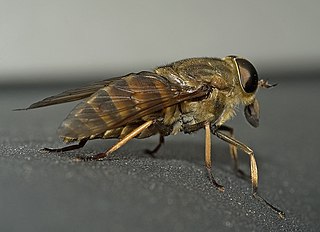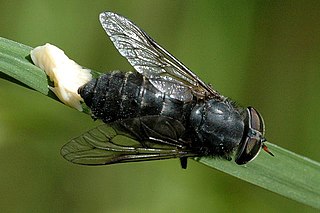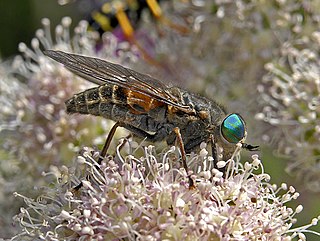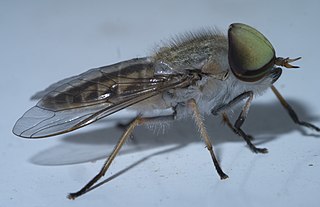
Horse-flies and deer flies are true flies in the family Tabanidae in the insect order Diptera. The adults are often large and agile in flight. Only female horseflies bite land vertebrates, including humans, to obtain blood. They prefer to fly in sunlight, avoiding dark and shady areas, and are inactive at night. They are found all over the world except for some islands and the polar regions. Both horse-flies and botflies (Oestridae) are sometimes referred to as gadflies.

Tabanus sudeticus, also known as the dark giant horsefly, is a species of biting horse-fly. It is the heaviest fly in Europe.

Hybomitra is a genus of horse flies in the family Tabanidae. There are at least 240 described species in Hybomitra.

Osca lata, the coliguacho or black horse fly, is a large horse fly whose range includes southern Chile and southern Argentina. The fly has a striking reddish-orange coloration on the side of its thorax and abdomen. It is generally around 2 cm. in adult size.
Neochrysops is a genus of horse flies in the family Tabanidae.

Hybomitra montana, the slender-horned horsefly, is a species of horse flies in the family Tabanidae.

Tabaninae is a subfamily in the family Tabanidae commonly known as horse flies. There are more than 3000 described species in Tabaninae.

Diachlorini is a tribe of horse flies in the family Tabanidae.

Tabanini is a tribe of horse and deer flies in the family Tabanidae. There are at least 220 described species in Tabanini.

Chrysopsinae is an insect subfamily in the family Tabanidae commonly known as deer flies or sheep flies and are bloodsucking insects considered pests to humans and cattle. They are large flies with large brightly-coloured compound eyes, and large clear wings with dark bands. They are larger than the common housefly and smaller than the horse-fly.
Agkistrocerus is a genus of horse flies in the family Tabanidae.

Haematopotini is a tribe of horse flies, also known as clegs and deer flies, in the family Tabanidae.

Pangoniinae is a subfamily of horse-flies in the order Diptera, containing at seven tribes and over 40 genera.

Scionini is a tribe of horse and deer flies in subfamily Pangoniinae of family Tabanidae.

Chrysopsini is a tribe of horse and deer flies in the family Tabanidae.
Roquezia is a genus of horse flies in the family Tabanidae.
Thaumastomyia is a genus of horse flies in the family Tabanidae.
Bouvieromyiini is a tribe of horse flies in the family Tabanidae.

Sphecodemyia is a genus of flies in the family Tabanidae.
Mackerrasia is a genus of horse flies in the family Tabanidae.













